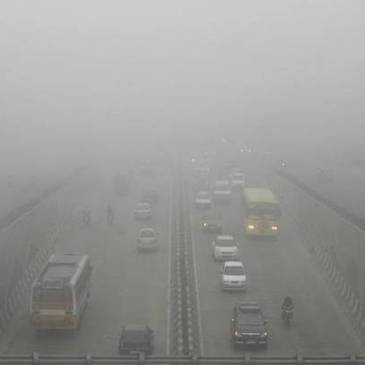The Cargo Carousel System
The animated video above depicts the most fundamental view of a new supply chain concept called the Cargo Carousel System (CCS). What you’re viewing are platforms suspended from crossbars and each crossbar has rollers on their ends that travel the length of a C-channel either forward or backward much like a garage door. The original concept was to put pallets of merchandise on each of these platforms to create an Automated Storage and Retrieval System (AS/RS) for the warehouse, but we soon realized that any overhang from the pallets would defeat the whole system. This is when we decided to add sides or walls to them to avoid overhang (as shown below). Pallets become cubic “modules” to utilize space most efficiently while better protecting contents and this entire system is then built into a framework so it can be inserted into a trailer or inter-modal steel shipping container. This creates an automated storage and retrieval system that is mobile and eliminates the need for loading docks. Forklifts no longer need to enter the container or trailer to access the merchandise, the cubic “modules” bring the merchandise to the doors of the container or trailer. When a module is removed from the Carousel it creates space to put another one back on in its place so deliveries and pickups (reverse logistics) can be done simultaneously. This also creates the start to a Circular Economy.
These artist’s renderings are examples of the checker board boxes in the video below:
(They can be custom built to suit any inventory shipping requirements)
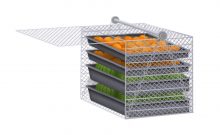
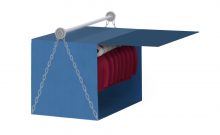
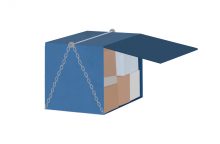
Racking Hanging Bulk

Ripen in Transit
A Complimentary System to Current Supply Chains
Four foot cubic “smart modules” replace pallets and can be brought to the doors of the container/trailer with the push of a button so forklifts can access them from ground level. 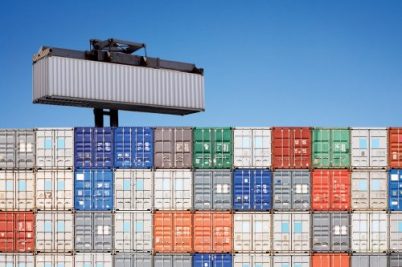 This means that containers can now be stacked as high as a forklift can reach while still being able to access their contents. By eliminating the need for loading docks you can store and access your inventory from anywhere that you can place an inter-modal steel shipping container much closer to your customers with a system that is completely complimentary to your existing supply chain operations.
This means that containers can now be stacked as high as a forklift can reach while still being able to access their contents. By eliminating the need for loading docks you can store and access your inventory from anywhere that you can place an inter-modal steel shipping container much closer to your customers with a system that is completely complimentary to your existing supply chain operations.
With the Cargo Carousel System (CCS) you simply fence off the space you require and stack as many units as you need right on the ground with virtually no change to existing infrastructure or processes. The cubic modules within the Carousel can be mixed and matched during transport so any transport company can handle them even if they aren’t using the CCS. This allows pooled or collaborative distribution between shippers to keep trucks full continuously on any leg of the upstream or downstream journey. And, its digital technology can not only track & trace but can also control the atmosphere inside each module from anywhere in the world with real-time alerting and logging with its cellular/satellite communications system.
Pooled Distribution Networks – The Cargo Carousel System
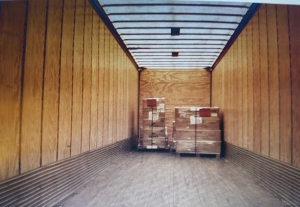 Our experience in logistics and distribution have made us realize that the two biggest problems with today’s supply chains continue to be a lack of visibility and underutilized space in both the warehouse and the container/trailer. The Cargo Carousel System virtually eliminates wasted space throughout the value chain and provides true Control Tower visibility.
Our experience in logistics and distribution have made us realize that the two biggest problems with today’s supply chains continue to be a lack of visibility and underutilized space in both the warehouse and the container/trailer. The Cargo Carousel System virtually eliminates wasted space throughout the value chain and provides true Control Tower visibility.
The only way to achieve “true” visibility in the supply chain is to keep the merchandise with the sensors and their readers continuously and between all modes of transport (ship, rail, truck, plane). The Cargo Carousel System achieves this visibility by changing value chains to value “networks” in the cloud while keeping all merchandise with their sensors (RFID, GPS, temperature, humidity, light exposure, O2, CO2, ethylene, etc.) and their readers continuously within the modules and between all modes of transport.  With this degree of visibility, combined with one of our modules that is opaque, lockable and sealable, collaborative or pooled distribution can be realized; that module now becomes no different than a Fedex package. It can now be handled by any LSP anywhere in the world and the CCS allows them to remotely monitor all sensors and unauthorized door openings of the cubic modules in real-time or unlock a module for anyone with the proper authorization anywhere in the world; we can even initiate instant video streaming from within the container/trailer to identify perpetrators and minimize theft.
With this degree of visibility, combined with one of our modules that is opaque, lockable and sealable, collaborative or pooled distribution can be realized; that module now becomes no different than a Fedex package. It can now be handled by any LSP anywhere in the world and the CCS allows them to remotely monitor all sensors and unauthorized door openings of the cubic modules in real-time or unlock a module for anyone with the proper authorization anywhere in the world; we can even initiate instant video streaming from within the container/trailer to identify perpetrators and minimize theft.
Eliminate Aisles in the Warehouse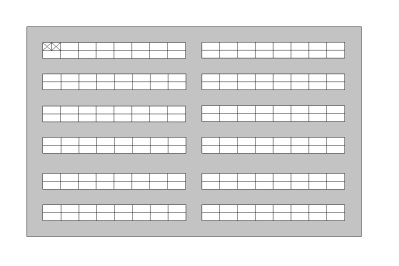
With regular racking, shown on the right, aisles are required (grey area) between the racks for forklifts to maneuver. This takes up more than half of the available cubic space in a warehouse. Add in the taxes, maintenance and heating bills that are paid on this unnecessarily wasted space and the cost per pallet position (shown as X’s) escalates dramatically with no increase in efficiency, flexibility, sustainability or scalability. The same number of pallet positions in the same cubic space area 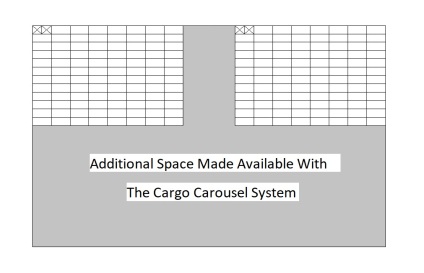 is shown to the left using the Cargo Carousel System but more than twice as much space (grey area) is available for the same number of pallet positions. The wireless sensors and controls (IoT) built into each module identifies the contents and atmospheric conditions in real-time to store and maintain a variety of merchandise with similar environmental requirements (there are a lot!) and includes alerting capabilities and continuous logging for historical auditing of operational metrics. Now, consider the effects on the efficiency, flexibility, sustainability and scalability of your supply chain when these same modules are taken on the road where they can eliminate empty back hauls by handling reverse logistics (recyclables, store returns, shelf pulls, overstocks, perishables, etc.) with the same system and at the same time; this truly is the starting point to creating a circular economy.
is shown to the left using the Cargo Carousel System but more than twice as much space (grey area) is available for the same number of pallet positions. The wireless sensors and controls (IoT) built into each module identifies the contents and atmospheric conditions in real-time to store and maintain a variety of merchandise with similar environmental requirements (there are a lot!) and includes alerting capabilities and continuous logging for historical auditing of operational metrics. Now, consider the effects on the efficiency, flexibility, sustainability and scalability of your supply chain when these same modules are taken on the road where they can eliminate empty back hauls by handling reverse logistics (recyclables, store returns, shelf pulls, overstocks, perishables, etc.) with the same system and at the same time; this truly is the starting point to creating a circular economy. 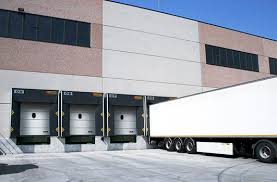 Since loading docks are not required and intermodal containers are weatherproof, merchandise can be stored much closer to the end user stacked in the parking lot of retail stores or fulfillment centers while peak season volumes are easily absorbed without the need for costly leases that go unused in the off season. These modules can also be double-stacked within the ISO container or trailer without crushing products underneath to maximize cubic space while in transit too.
Since loading docks are not required and intermodal containers are weatherproof, merchandise can be stored much closer to the end user stacked in the parking lot of retail stores or fulfillment centers while peak season volumes are easily absorbed without the need for costly leases that go unused in the off season. These modules can also be double-stacked within the ISO container or trailer without crushing products underneath to maximize cubic space while in transit too.
Returnable Packaging
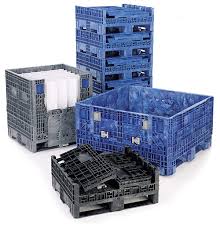 Returnable packaging isn’t very effective if it doesn’t get returned. The Cargo Carousel System guarantees the return of your packaging by allowing delivery and pick-up at the same time and at any stop up or down the value chain. Each time a “module” is removed from the Carousel it opens up a position for another module to take its place ensuring your reusable packaging is returned while also keeping it protected from theft. These standard sized reusable modules are lockable and replace wooden pallets and plastic wrap to offer superior protection and each of them are suspended from the Carousel to better absorb shock.
Returnable packaging isn’t very effective if it doesn’t get returned. The Cargo Carousel System guarantees the return of your packaging by allowing delivery and pick-up at the same time and at any stop up or down the value chain. Each time a “module” is removed from the Carousel it opens up a position for another module to take its place ensuring your reusable packaging is returned while also keeping it protected from theft. These standard sized reusable modules are lockable and replace wooden pallets and plastic wrap to offer superior protection and each of them are suspended from the Carousel to better absorb shock.
Standardization allows any 3PL, distributor, producer, military or disaster relief/humanitarian aid agencies to use these same modules in any leg of their supply or reverse chains. 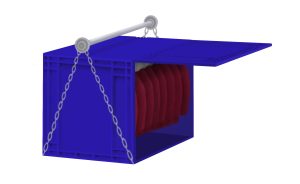 Each module can be closed, locked and sealed so anyone can use or transport them because every module is interchangeable with every Carousel. Interchangeability is one of the hallmarks of the Cargo Carousel System.
Each module can be closed, locked and sealed so anyone can use or transport them because every module is interchangeable with every Carousel. Interchangeability is one of the hallmarks of the Cargo Carousel System.
Modules can be built as racks to carry trays or built with cross-bars at the top to transport and store or display garments. In more general applications they can replace pallets to carry totes or other returnable packaging or stand alone to carry consumer packaged goods that are still being shipped in cardboard boxes. 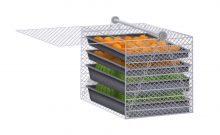 Regardless of their purpose, all modules fit on the Carousel to allow full height utilization of the trailer or container without crushing the merchandise underneath.
Regardless of their purpose, all modules fit on the Carousel to allow full height utilization of the trailer or container without crushing the merchandise underneath.
By consolidating or pooling LTL shipments, companies can achieve organic growth by increasing the utilization of their “existing” wasted space (that they’re already paying for anyway) on their trucks/trailers/containers or in their warehouses. Keeping trucks full by continuously pooling LTL shipments can eliminate empty back hauls while achieving end-to-end visibility in both, the supply and reverse chains.

